Top 5 Uniquely Designed Party Games (From the Perspective of a Casual Game Designer)

I find it hard to believe I make and play games for a living. I plunged into this madness in 2017 when my childhood friend Jon and I launched Wing It, and since then it’s been a wild journey. Designing games at a time when an estimated 7,000 games come out each year makes it a TOUGH industry, but it is precisely because we are now in a time of “a board game renaissance” – that it’s also a FANTASTIC time to be making them. Well-designed, unique games are coming out all the time and as a designer I can rarely get enough play time in.
To narrow down the field of awesomeness at your local game store library, café, or bar, I’ve put together a short list of my personal favorites, as far as unique game design, from the perspective of a designer of casual games (me). These games are not only fun to play every time; they’re also impressive and unusual in their design. More importantly, most of these appeal to both the casual gamer and the light strategy gamer, so they’re easy crowd pleasers.
After you look through the list, chime in: what do you disagree with here? Which party games would make your list?
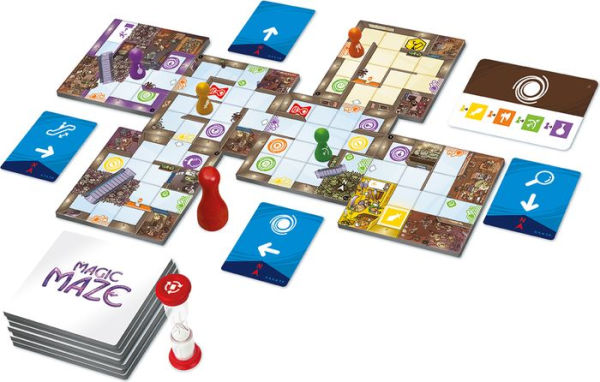
1) Magic Maze
How to play: In this fast-paced cooperative game, gamers play 4 magical creatures trying to steal magical objects for their quest from the Magic Mall before escaping the mall. If they don’t escape before the timer runs out, that means they have been caught by mall security. There is no talking, no assigned characters, and no turns (!), so everyone is moving all creatures at once according to what move(s) they are allowed to make, all in a mad dash to escape… and in total quiet.
My love affair with Magic Maze began late one night while ambling around the convention Dreamation in a full gorilla suit, my business casual wear for cons. A group invited me to play and after one round, I was hooked.
Why do I love it?
First of all, the theme matches the game play mechanism perfectly. Many games have a mechanism with a theme randomly tacked on, but in Magic Maze, you feel that rush, that stress as you desperately race through the mall trying to escape. If you were actually stealing from a mall, you would be stressed, and that nervous, excited energy runs throughout the game. In the same vein, were you actually trying to escape before being caught, you wouldn’t make noise lest mall security discover you. Lastly, the “Magic Mall,” i.e. the board, grows as you play AND changes every round, which makes sense for a physical space created with magic.
The difficulty in mastering Magic Maze means that even your sharpest, fastest paced friends will not get bored anytime soon. And if you DO master it, several higher levels of play make the elusive win even harder to come by!
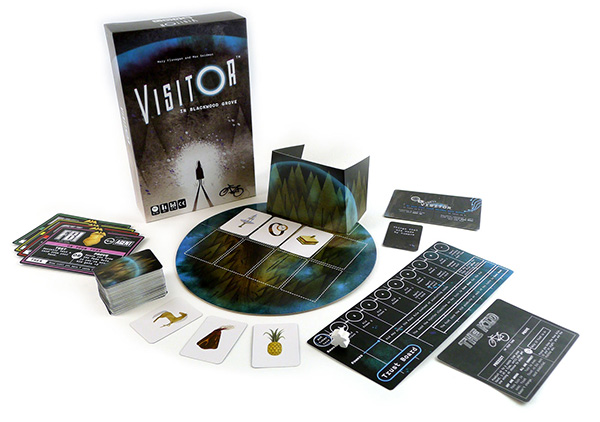
2) Visitor in Blackwood Grove
How to Play: One player is the Visitor, an alien whose spaceship is in the woods and surrounded by a protective force field. Another player is the Kid, and everyone else plays agents from government spy agencies. The alien creates a rule about which kinds of objects can enter the force field, and the Kid and secret agents compete to determine which objects fit the rule first.
Why do I love it?
I love this game partly because it’s an advanced logic puzzle: coming up with all the odd ways in which totally random objects are connected is alone a fun mental puzzle. I also appreciate it because it is, like many beloved, classic party games (Taboo, Balderdash), easy to learn but hard to master. I played with my cousin and his friends – a group of serious gamers – and, depending on the rule, we were all completely stumped in more than one round. It helps to know how the person playing the alien thinks but even then, the rule may be so obscure that even absolutely confident gamers will declare what they believe to be The Rule!…only to learn they’re wrong.
And, of course, I can’t help but mention that Visitor in Blackwood Grove obviously capitalizes on the current wave of ‘80s nostalgia driven by Stranger Things. And who doesn’t love ET?!
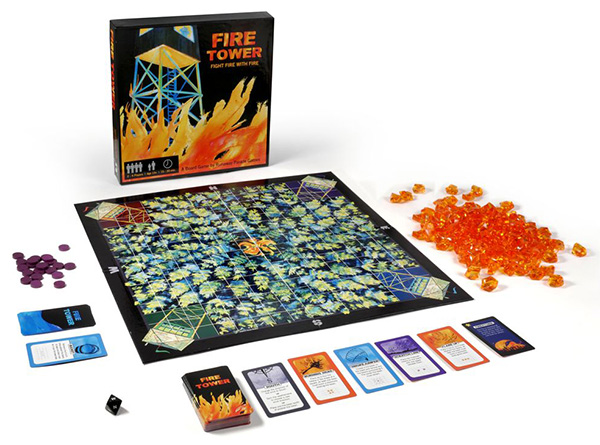
3) Fire Tower
How to Play: Players must burn the other person’s fire tower down before their own is burnt down.
Why do I love it?
Fire Tower is another game in which the theme matches the mechanisms strikingly well. Just as fire changes direction and rages beyond your control, the 3D flames change wind direction and intensity through a mix of luck and strategy. The game’s dramatic unpredictability gives you the thrill of excitement and trepidation as a card like Firestorm is played and suddenly the flames advance on all sides towards players’ precarious towers.
I find the blend of luck and light strategy to, once again, be broadly appealing to both the party game crowd and the light strategy game crowd. As with similar games, you don’t necessarily want to play your best cards early on because you may end up with a downright useless hand when you’re most in need of fighting the raging flames. The game’s “likely” winner may shift constantly based on a single card during a single turn.
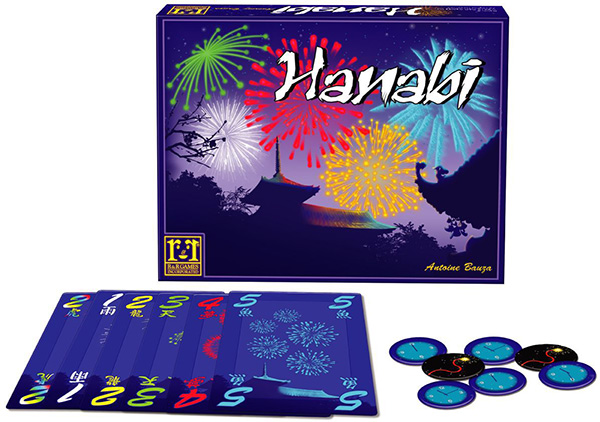
4) Hanabi
How to Play: This cooperative game involves creating a fireworks show, putting fireworks in order on the table by number and color. The catch is, you can’t see your own cards; you can only see everyone else’s cards!
Why do I love it?
The unique element Hanabi adds is that you can’t see your own cards; you are entirely reliant on other people telling you about your own hand and vice versa.
Every. Turn. Matters. So you have to think 2, 3, or even 4 turns ahead for both yourself AND other players. You need to make sure all other players will have a helpful play on their turn, or you have ALL wasted a turn and you’re unlikely to reach the highest point level of 25. The constant strategic collaboration required means every turn counts.
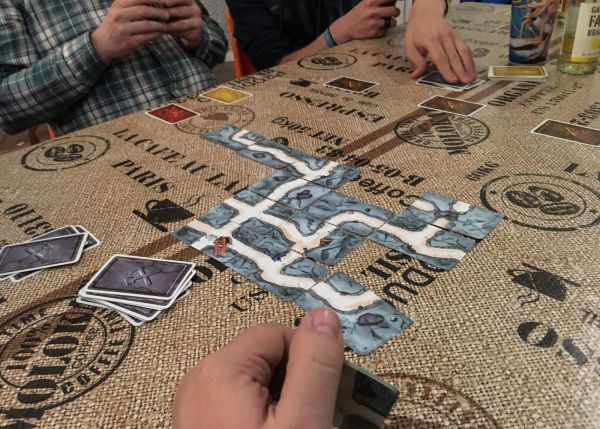
(Source: Achim Raschka on Wikimedia Commons — used under CC BY-SA 4.0 license)
5) Saboteur
How to Play: This social deduction and tunnel building game pits miners versus saboteurs as the miners try to reach the gold via a tunnel before the saboteurs destroy the miners’ path to the gold. The catch? No one knows what role anyone else is playing.
Why do I love it?
Let’s be honest, fooling your friends is fun. Most of us don’t lie in our everyday lives, so testing your savviness for fooling entire groups of people is rare and mischievous fun. But not all social deduction games are equal. What makes Saboteur stand out above other more recent social deduction games (Secret Hitler, One Night Ultimate Werewolf) is in how it handles the hidden identity. First of all, the “cooperative” activity of tunnel building allows you to pretend to be one role for as many turns as you wish so you can stay undercover. In similar games, at least some players know who the other bad dudes are and can collaborate more easily. In Saboteur, no one knows anyone’s role, so you can keep people confused easily, even your own “Team!”
The (basic) complexity of Saboteur and length of time for the miners to win allows you to spend time “helping” the other team even if you’re plotting to rapidly destroy their tunnel at the last moment.
Now that you’ve heard my own top 5 unique party games, let us know your own favorites below! And if you recommend one I’ve never played, I’ll be sure to check it out!
Molly Zeff is the CEO and cofounder of the indie publishing company Flying Leap Games, founded in 2017. Through Flying Leap Games, Molly and cofounder/childhood friend Jon Cannon created “Wing It: The Game of Extreme Storytelling;” “Wing It: Beyond,” the first expansion due out this March; and a third riotously fun new game due out August 2019 (to be revealed at the GAMA Trade Show). Wing It was called “one of the biggest successes” by retailers of the GAMA Trade Show in 2018 and sold out of its first printing just 4 weeks after GAMA.





I'd love to play Magic Maze, I love cooperative games.
Commercial Carpet Cleaning
Thanks you for amazing blog
Thanks you for amazing blog